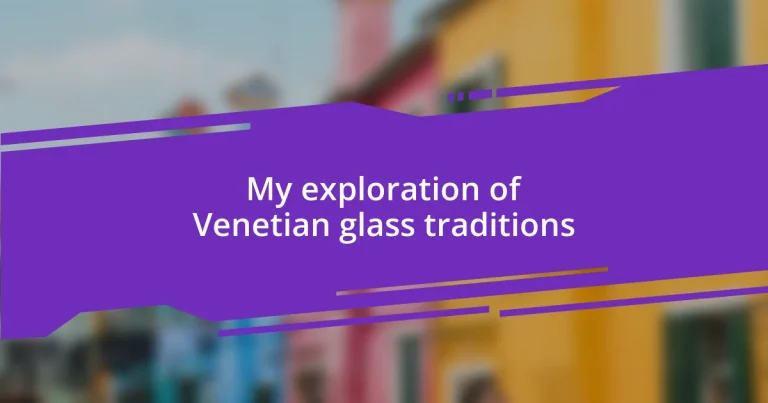Key takeaways:
- Venetian glass boasts a rich history spanning over a thousand years, marked by strict regulations that preserved artisans’ techniques and elevated glass to a symbol of luxury.
- Key techniques in glassblowing, such as gathering, blowing, shaping, and annealing, showcase the intricate artistry and dedication of craftsmen, revealing a passionate tradition passed through generations.
- Modern trends in Venetian glassmaking blend innovation with sustainability, as artisans explore contemporary designs and utilize recycled materials, while technology enhances traditional practices and the artistic legacy continues to evolve.

Understanding Venetian glass history
Venetian glass has a rich history that dates back over a thousand years. I remember walking through Murano, the island renowned for its glass-making, and feeling a profound sense of tradition in the air. How incredible is it to think that artisans have honed their craft here for centuries, each piece a testament to a forgotten era?
In the 13th century, glass production in Venice flourished, especially following the establishment of strict regulations to protect the craft and its secrets. I often find myself pondering the lengths these artisans went to ensure their techniques remained undisclosed—what drives someone to safeguard their knowledge so fiercely? This dedication has not only preserved the craft but has also made Venetian glass a symbol of luxury and artistry across the globe.
The artistry of Venetian glass reached its zenith during the Renaissance, when it became highly sought after by royalty and the affluent. As I gazed at beautifully intricate chandeliers in historical palaces, I couldn’t help but feel a deep connection to the past, imagining what those grand halls might have looked like illuminated by these delicate creations. Isn’t it fascinating how a single piece of glass can transport us through time, reflecting the mastery of its creators?

Key techniques in glassblowing
One of the most fascinating aspects of Venetian glassblowing lies in the techniques that have been passed down through generations. Watching a skilled glassblower at work was nothing short of mesmerizing. The way they transformed molten glass into delicate shapes with just a few swift movements left me in awe. It’s a balance of art and physics—understanding both how to manipulate the material while creating something exquisite.
Here are some key glassblowing techniques that highlight this traditional craft:
-
Gathering: This is the first step where the glassblower gathers molten glass from a furnace on the end of a blowpipe to start shaping it. I remember seeing the vibrant orange glow as they gathered a large glob that would soon become something beautiful.
-
Blowing: This technique involves blowing air into the glass through the pipe. I could hardly believe that a few gentle breaths could expand the glass into complex forms.
-
Shaping: Tools known as jacks and paddles are used during shaping to refine the piece. It felt like watching a sculptor mold clay; the precision required was astonishing.
-
Annealing: After shaping, the glass must be slowly cooled in an annealer to relieve internal stresses. The patience of this process echoed the dedication of crafting glass over days and weeks—not just in the moment.
-
Applying Colors and Decorations: Various methods, like applying gold leaf or colored sands, allow artisans to add intricate details to their creations. Standing amid the vibrant colors, I felt the rich cultural heritage splashed vividly across each piece.
These techniques, refined through centuries, not only reveal the craftsmanship of their makers but also tell a story about the passion and tradition behind Venetian glass.

Major Venetian glass artisans
As I wandered through the quaint streets of Murano, I became captivated by the stories behind major Venetian glass artisans. One name that stands out is Angelo Barovier, who revolutionized the glass-making industry in the 14th century. Known for his groundbreaking innovation in transparent glass, he left a lasting legacy that other craftsmen still admire today. I felt a thrill just imagining how his techniques changed the game for artisans who came after him.
Another remarkable figure is Archimede Seguso, whose whimsical designs brought a fresh perspective to the craft in the 20th century. I distinctly remember encountering one of his playful glass sculptures—its vivid colors and unusual shape seemed to dance in the light. It reminded me that artistry is not just about tradition; it’s also about daring to express oneself through unique creations. Seguso’s work embodied the evolution of Venetian glass, showing that artisans self-express while honoring a historical craft.
Finally, let’s not overlook Salviati, a brand founded in the 19th century that excelled in using ancient glass-making techniques to create stunning modern pieces. Visiting their workshop was like stepping into a treasure trove of history and creativity. Their commitment to preserving traditional methods while embracing innovation truly resonated with me; it demonstrated how the spirit of Venetian glass art continues to thrive, transcending generations.
| Artisan | Known For |
|---|---|
| Angelo Barovier | Innovating transparent glass in the 14th century |
| Archimede Seguso | Whimsical designs and vibrant colors in the 20th century |
| Salviati | Blending ancient techniques with modern artistry |

Exploring Murano glass factories
As I ventured into the Murano glass factories, I was struck by the palpable energy in the air. Each workshop buzzed with the sounds of tools clinking and glass being shaped. It felt like stepping into a live performance where the artisans were both artists and magicians, transforming raw material into stunning glassworks right before my eyes. I couldn’t help but wonder—what drives these artisans to dedicate their lives to such an intricate craft?
Walking through the brightly lit factories, I was enraptured by the vibrant colors and unique designs that adorned every piece. One artisan invited me to try my hand at glassblowing, and though I was nervous, I took a deep breath and stepped up. While I struggled to maintain control over the blowpipe, I gained a newfound appreciation for the years of practice and dedication that these craftsmen possess. It was an enlightening experience that solidified my understanding of how every bubble and swirl in the glass tells a story of mastery.
What really touched me was witnessing the camaraderie among the artisans. They often shared tips and encouragement, creating a community that feels almost familial. I recall one artisan expressing pride in passing down a specific technique to his daughter. Watching that exchange made me realize that Murano’s glassblowing tradition doesn’t just rest on skilled hands; it’s also about love, trust, and nurturing a passion for art through generations. How beautiful it is that this craft connects people—not just to their heritage but to one another!

Identifying authentic Venetian glass
Identifying authentic Venetian glass can sometimes feel like deciphering a complex puzzle. One of my most memorable experiences was examining the surface of a Murano glass vase. The craftsmanship was immediately evident; the sheen was not just a result of polish but a depth created through skillful layering. You see, genuine Venetian glass often displays subtle imperfections, such as small bubbles or slight variations in thickness, which only add to its uniqueness.
When you’re in the market for authentic pieces, check for the “Murano Glass” signature. I learned this while admiring a dazzling chandelier—it had an engraved label that confirmed its provenance. However, don’t rely solely on labels; understanding the craftsmanship is equally vital. Seeing how the artisans meticulously shape the glass leads me to trust my eye. For me, watching the passionate details in the creation process enhances the piece’s authenticity.
Another key feature to observe is the vibrant colors derived from real glass rather than paint. I’ll never forget the moment I picked up a glass figurine with radiant hues that shifted in the light. This color saturation comes from high-quality materials and traditional processes, distinguishing authentic Venetian glass from mass-produced substitutes. So, the next time you admire a piece, ask yourself: what story does this color tell? Authenticity stems from the intersection of artistry and heritage, encapsulating a world of history in each vibrant creation.

Caring for Venetian glass
Caring for Venetian glass requires a certain reverence. When I first received a delicate Murano glass piece as a gift, I was nervous about keeping it intact. I learned quickly that proper storage is crucial—keeping such treasures in a cushioned display case away from direct sunlight not only protects their brilliant colors but also prevents accidental breakage.
Cleaning is another essential aspect, and I discovered a gentle touch goes a long way. Using a soft, lint-free cloth and lukewarm water to wipe the surface helps maintain the glass’s pristine condition without scratching it. I remember a harrowing moment when I almost reached for a rough sponge after a messy dinner party. The thought of damaging my beautiful glass piece stopped me in my tracks—what if I lost the artistry of that stunning craftsmanship over something so simple?
Lastly, I realized that avoiding temperature extremes is key. Venetian glass can be sensitive, so I keep my treasured pieces away from heaters or air conditioning vents. I once placed a gorgeous vase near a vent, only to watch in horror as the temperature fluctuated and created tiny cracks. It’s moments like these that reinforce the idea that caring for Venetian glass is not just about physical protection; it’s about cherishing the stories and emotions embedded in each piece. How could one not consider the care of such exquisite art a vital practice?

Modern trends in Venetian glassmaking
Modern trends in Venetian glassmaking reflect a fascinating blend of tradition and innovation. I recall visiting a workshop where artisans were experimenting with contemporary designs while still honoring age-old techniques. This fusion creates pieces that delight both traditionalists and modern art enthusiasts alike. Have you ever seen a Murano glass sculpture that seems to defy gravity? It’s mesmerizing how these talented artists push the boundaries of what glass can do.
Recently, I’ve noticed an increasing emphasis on sustainability within the Venetian glass community. Many artisans are sourcing recycled materials to reduce their environmental footprint. I once encountered a stunning series of vases crafted from glass remnants, each piece telling its own story of reclamation. This practice not only preserves the artistry of glassmaking but also cultivates a deeper connection between the artist, the material, and the environment. How wonderful it is to see creativity entwined with responsibility!
Another exciting trend is the integration of technology in glassmaking. During one visit to a glass studio, I marveled at how artisans used digital design tools to map out intricate patterns, which they then brought to life through traditional blowing techniques. I couldn’t help but think: how does technology enhance the timeless beauty of Venetian glass? The resulting pieces are not just functional but also serve as mesmerizing works of art, blurring the lines between craftsmanship and modern design. This evolution excites me, knowing that the legacy of Venetian glass is not only preserved but also continuously redefined.














